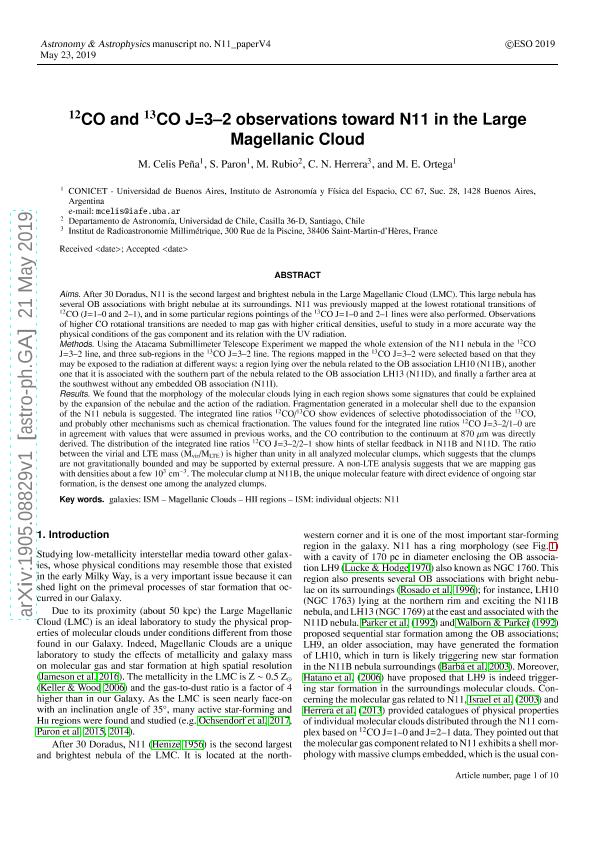Mostrar el registro sencillo del ítem
dc.contributor.author
Celis Peña, Mariela Fernanda

dc.contributor.author
Paron, Sergio Ariel

dc.contributor.author
Rubio, M.
dc.contributor.author
Herrera, C.N.
dc.contributor.author
Ortega, Martin Eduardo

dc.date.available
2023-08-24T12:11:23Z
dc.date.issued
2019-08
dc.identifier.citation
Celis Peña, Mariela Fernanda; Paron, Sergio Ariel; Rubio, M.; Herrera, C.N.; Ortega, Martin Eduardo; 12CO and 13CO J = 3-2 observations toward N11 in the Large Magellanic Cloud; EDP Sciences; Astronomy and Astrophysics; 628; A96; 8-2019; 1-10
dc.identifier.issn
0004-6361
dc.identifier.uri
http://hdl.handle.net/11336/209182
dc.description.abstract
Aims. After 30 Doradus, N11 is the second largest and brightest nebula in the Large Magellanic Cloud (LMC). This large nebula has several OB associations with bright nebulae at its surroundings. N11 was previously mapped at the lowest rotational transitions of 12CO (J = 1-0 and 2-1), and in some particular regions, pointings of the 13CO J = 1-0 and 2-1 lines were also performed. Observations of higher CO rotational transitions are needed to map gas with higher critical densities, which are useful to study the physical conditions of the gas component and its relation with the UV radiation more accurately. Methods. Using the Atacama Submillimeter Telescope Experiment, we mapped the whole extension of the N11 nebula in the 12CO J = 3-2 line and three subregions in the 13CO J = 3-2 line. The regions mapped in the 13CO J = 3-2 were selected with the criterion that they were to be exposed to the radiation in different ways: a region lying across the nebula, which is related to the OB association LH10 (N11B), another region that it is associated with the southern part of the nebula, which is related to the OB association LH13 (N11D), and finally an area farther away in the southwest without any embedded OB association (N11I). Results. We found that the morphology of the molecular clouds lying in each region shows some signatures that could be explained by the expansion of the nebulae and the action of the radiation. Fragmentation generated in a molecular shell due to the expansion of the N11 nebula is suggested. The integrated line ratios 12CO/13CO show evidence of selective photodissociation of the 13CO, and probably other mechanisms such as chemical fractionation. The values found for the integrated line ratios 12CO J = 3-2/1-0 are in agreement with values that were assumed in previous works, and the CO contribution to the continuum at 870 μm was derived directly. The distribution of the integrated line ratios 12CO J = 3-2/2-1 show indications of stellar feedback in N11B and N11D. The ratio between the virial and local thermal equilibrium (LTE) mass (Mvir/MLTE) is higher than unity in all analyzed molecular clumps, which suggests that the clumps are not gravitationally bounded and may be supported by external pressure. A non-LTE analysis suggests that we map gas with densities of about a few 103 cm-3. The molecular clump at N11B, the unique molecular feature with direct evidence of ongoing star formation, is the densest of the clumps we analyzed.
dc.format
application/pdf
dc.language.iso
eng
dc.publisher
EDP Sciences

dc.rights
info:eu-repo/semantics/openAccess
dc.rights.uri
https://creativecommons.org/licenses/by-nc-sa/2.5/ar/
dc.subject
GALAXIES: ISM
dc.subject
HII REGIONS
dc.subject
ISM: INDIVIDUAL OBJECTS: N11
dc.subject
MAGELLANIC CLOUDS
dc.subject.classification
Astronomía

dc.subject.classification
Ciencias Físicas

dc.subject.classification
CIENCIAS NATURALES Y EXACTAS

dc.title
12CO and 13CO J = 3-2 observations toward N11 in the Large Magellanic Cloud
dc.type
info:eu-repo/semantics/article
dc.type
info:ar-repo/semantics/artículo
dc.type
info:eu-repo/semantics/publishedVersion
dc.date.updated
2019-12-18T13:53:17Z
dc.journal.volume
628
dc.journal.number
A96
dc.journal.pagination
1-10
dc.journal.pais
Francia

dc.journal.ciudad
París
dc.description.fil
Fil: Celis Peña, Mariela Fernanda. Consejo Nacional de Investigaciónes Científicas y Técnicas. Oficina de Coordinación Administrativa Ciudad Universitaria. Instituto de Astronomía y Física del Espacio. - Universidad de Buenos Aires. Facultad de Ciencias Exactas y Naturales. Instituto de Astronomía y Física del Espacio; Argentina
dc.description.fil
Fil: Paron, Sergio Ariel. Consejo Nacional de Investigaciónes Científicas y Técnicas. Oficina de Coordinación Administrativa Ciudad Universitaria. Instituto de Astronomía y Física del Espacio. - Universidad de Buenos Aires. Facultad de Ciencias Exactas y Naturales. Instituto de Astronomía y Física del Espacio; Argentina
dc.description.fil
Fil: Rubio, M.. Universidad de Chile; Chile
dc.description.fil
Fil: Herrera, C.N.. Institut de Radioastronomie Millimétrique; Francia
dc.description.fil
Fil: Ortega, Martin Eduardo. Consejo Nacional de Investigaciónes Científicas y Técnicas. Oficina de Coordinación Administrativa Ciudad Universitaria. Instituto de Astronomía y Física del Espacio. - Universidad de Buenos Aires. Facultad de Ciencias Exactas y Naturales. Instituto de Astronomía y Física del Espacio; Argentina
dc.journal.title
Astronomy and Astrophysics

dc.relation.alternativeid
info:eu-repo/semantics/altIdentifier/url/https://www.aanda.org/articles/aa/abs/2019/08/aa35446-19/aa35446-19.html
dc.relation.alternativeid
info:eu-repo/semantics/altIdentifier/doi/https://doi.org/10.1051/0004-6361/201935446
dc.relation.alternativeid
info:eu-repo/semantics/altIdentifier/arxiv/https://arxiv.org/abs/1905.08829
Archivos asociados
